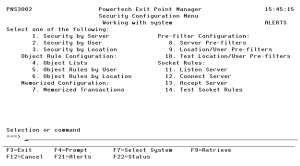Security Configuration Menu
How to Get There
From the Main Menu, choose option 1.
What it Does
The Security Configuration Menu allows you to navigate to access control settings by server, user, location, and object. It also allows you access to Pre-filter and Socket Rule settings.
Options
1. Security by Server
The Work with Security by Server panel allows you to view or change Server Function Rules.
2. Security by User
The Work with Security by User panel allows you to view or change User Rules.
3. Security by Location
The Work with Security by Location panel allows you to view or change Locations Rules.
Object Rule Configuration:
4. Object Lists
The Work with Object Lists panels allow you to create, modify, delete and perform other operations upon Object Lists. An Object list is a list of names of objects. These lists of objects are attached to Users or Locations on Object Rules. These rules help protect objects from outside access.
5. Object Rules by User
The Work with Object Rules by User panels allow you to create modify, and delete Object Rules that pertain to Users. Object Rules can be active or inactive. On this panel, the inactive rules are colored yellow and the active rules are colored green.
6. Object Rules by Location
The Work with Object Rules by Location panels allow you to create, modify, and delete Object Rules. Object Rules can be active or inactive. On this panel, the inactive rules are colored yellow and the active rules are colored green.
Memorized Configuration:
7. Memorized Transactions
The Work with Memorized Transactions panel allows you to display, change, copy and delete Memorized Transactions.
Pre-filter Configuration:
8. Server Pre-Filters
This option allows you to display or change server-level pre-filters. See Work with Server Pre-Filters panel.
9. Location/User Pre-Filters
This option allows you to display, change, add, or delete location and user level pre-filters. See Work with Location/User Pre-Filter panel.
10. Test Location/User Pre-filters
This option allows you to test pre-filters. See Test Location/User Pre-Filters.
Socket Rules:
11. Listen Server
This option allows you to work with Socket Rules for the Listen Server. See Work with Socket Rules - Listen Server.
12. Connect Server
This option allows you to work with Socket Rules for the Connect Server. See Work with Socket Rules - Connect Server.
13. Accept Server
This option allows you to work with Socket Rules for the Accept Server. See Work with Socket Rules - Accept Server.
14. Test Socket Rules
This option allows you to test Socket Rules. See Test Socket Rules.
Command Keys
F3 (Exit): Exit the menu.
F4 (Prompt): Provides assistance in entering or selecting a command.
F7 (Select System): Use this command key to work with data from a different System.
F9 (Retrieve): Displays the last command you entered on the command line and any parameters you included. Pressing this key once shows the last command you ran. Pressing this key twice shows the command you ran before that, and so on.
F12 (Cancel): Returns to the previous menu or display.
F21 (Alerts): Displays the Alerts panel where Powertech products can post errors, warnings or other general notifications to the administrator.
F22 (Status): Displays the Operational Resources pop-up window containing the status of several operation aspects of Powertech products.
